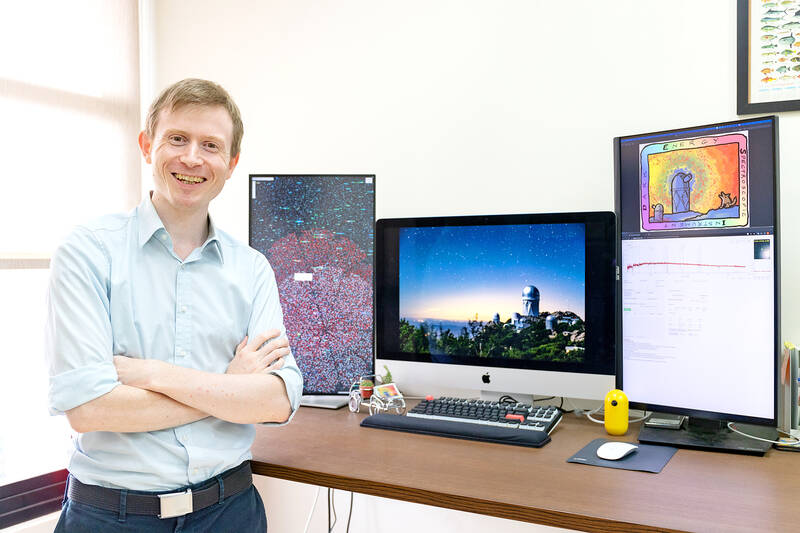The first 2 million entries in a database to create a 3D map of the observable universe were released yesterday, made possible with contributions from National Tsing Hua University (NTHU) researchers.
The Dark Energy Spectroscopic Instrument (DESI) brings together more than 70 research institutions, and hundreds of scientists and engineers around the globe to create an interactive map showing the composition and movements of stars and galaxies.
“We’re making a 3D map of the universe,” said Andrew Cooper, a British assistant professor at NTHU’s Institute of Astronomy who is involved in the project.

Photo courtesy of Andrew Cooper
The project is headed by the California-based Lawrence Berkeley National Lab and funded by the US Department of Energy’s Office of Science.
By 2025, DESI is expected to have data for more than 40 million galaxies, quasars and stars, including those in the Milky Way, distant galaxies, as well as supermassive black holes.
DESI was created to explore “dark energy,” what scientists believe is behind the acceleration of the expansion of the universe, Cooper said in a news release.
After a decade of planning and construction, instruments at Kitt Peak Observatory in Arizona began mapping the cosmos in 2021, he said.
DESI’s focal plane has 5,000 robotic positioners, each holding a fiberoptic cable to gather the light from an individual star or galaxy, Cooper said.
Its back end is filled with sensors to process spectral data that can be used to analyze how fast stars and galaxies are moving relative to Earth, and details about stars in the Milky Way, he added.
Cooper was one of the two leaders of the DESI Milky Way Survey to analyze the spectra of stars in our galaxy.
The first release of DESI data includes about 500,000 of these stars, the news release said, adding that the findings have been published in the Astrophysical Journal.
With enough spectral data from the Milky Way, Cooper hopes that astronomers could use DESI’s 3D map to test theories about the nature of dark matter.
The NTHU team working on DESI includes two doctoral students from the Institute of Astronomy — Namitha Kizhuprakkat from India and Liao Li-wen (廖俐雯) — as well as Department of Physics undergraduate Pu Sy-yun (蒲思云), the news release said.
National Taiwan University Institute of Astrophysics assistant professor Lan Ting-wen (藍鼎文) is also involved in the DESI project, coordinating a team to verify data.
More information can be found at https://data.desi.lbl.gov/doc.

US climber Alex Honnold is to attempt to scale Taipei 101 without a rope and harness in a live Netflix special on Jan. 24, the streaming platform announced on Wednesday. Accounting for the time difference, the two-hour broadcast of Honnold’s climb, called Skyscraper Live, is to air on Jan. 23 in the US, Netflix said in a statement. Honnold, 40, was the first person ever to free solo climb the 900m El Capitan rock formation in Yosemite National Park — a feat that was recorded and later made into the 2018 documentary film Free Solo. Netflix previewed Skyscraper Live in October, after videos

Starting on Jan. 1, YouBike riders must have insurance to use the service, and a six-month trial of NT$5 coupons under certain conditions would be implemented to balance bike shortages, a joint statement from transportation departments across Taipei, New Taipei City and Taoyuan announced yesterday. The rental bike system operator said that coupons would be offered to riders to rent bikes from full stations, for riders who take out an electric-assisted bike from a full station, and for riders who return a bike to an empty station. All riders with YouBike accounts are automatically eligible for the program, and each membership account

NUMBERS IMBALANCE: More than 4 million Taiwanese have visited China this year, while only about half a million Chinese have visited here Beijing has yet to respond to Taiwan’s requests for negotiation over matters related to the recovery of cross-strait tourism, the Tourism Administration said yesterday. Taiwan’s tourism authority issued the statement after Chinese-language daily the China Times reported yesterday that the government’s policy of banning group tours to China does not stop Taiwanese from visiting the country. As of October, more than 4.2 million had traveled to China this year, exceeding last year. Beijing estimated the number of Taiwanese tourists in China could reach 4.5 million this year. By contrast, only 500,000 Chinese tourists are expected in Taiwan, the report said. The report

Temperatures are forecast to drop steadily as a continental cold air mass moves across Taiwan, with some areas also likely to see heavy rainfall, the Central Weather Administration (CWA) said. From today through early tomorrow, a cold air mass would keep temperatures low across central and northern Taiwan, and the eastern half of Taiwan proper, with isolated brief showers forecast along Keelung’s north coast, Taipei and New Taipei City’s mountainous areas and eastern Taiwan, it said. Lows of 11°C to 15°C are forecast in central and northern Taiwan, Yilan County, and the outlying Kinmen and Lienchiang (Matsu) counties, and 14°C to 17°C